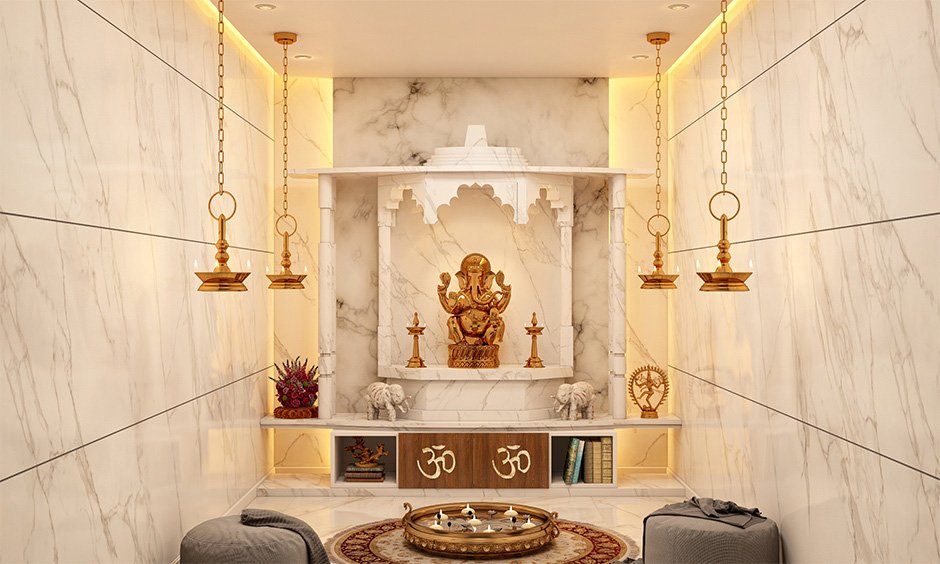Home Temples: Creating a Sacred Space in Your Living Environment

Home temples, also known as puja mandirs or prayer rooms, have become a staple in many households around the world, providing a peaceful space for worship, meditation, and spiritual reflection. Integrating a dedicated area for a temple within the home helps create an atmosphere of positivity, peace, and tranquility. In this guide, we explore various types of home temples, design ideas, placement tips, and materials to consider for establishing a serene and spiritual environment.
1. Types of Home Temples
A. Wall-Mounted Temples
Ideal for compact spaces, wall-mounted temples are designed to occupy minimal floor space while maintaining an elegant look. These are usually crafted from wood, metal, or even marble and can range from simple shelves with images of deities to elaborate enclosed structures.
B. Freestanding Temples
Freestanding temples are larger, standalone units that resemble miniature versions of traditional temple structures. These can be placed in any corner of the room and often feature intricate carvings, doors, and drawers for storing prayer items.
C. Inbuilt Temple Cabinets
Inbuilt temple cabinets are designed within existing furniture, like cupboards or bookshelves, making them discreet yet functional. This option works well for homes with limited space and offers a customizable way to create a sacred area without disrupting the room’s aesthetics.
D. Portable Temples
Portable or foldable temples are easy to move and perfect for people who like to change the location of their puja space. They are typically small and lightweight, crafted from wood or metal, and allow for flexibility in placement.
2. Ideal Placement for a Home Temple
A. Position and Direction
According to Vastu Shastra, an ancient Indian science of architecture, it’s ideal to place the temple in the northeast corner of the house. This direction is considered auspicious as it receives morning sunlight, which is believed to purify the space. If the northeast is not an option, the east or north direction is also considered favorable.
B. Separate Area
Whenever possible, dedicate a separate room for the temple, especially if the home is spacious. If space is limited, a corner or niche can work well. The important factor is that it should be a peaceful area with minimal interruptions.
C. Avoiding Certain Areas
Avoid placing the temple under a staircase, in the bedroom, or near bathrooms, as these locations are generally considered unsuitable for a sacred space. If a separate room is not feasible, a small dedicated shelf or corner in the living area works well.
3. Design Ideas for Home Temples
A. Traditional Wooden Temple Designs
Wooden temples are timeless and offer a classic, elegant look. They come in various types of wood, such as teak, rosewood, and mahogany, and often feature intricate carvings, latticework, and archways. Traditional designs lend warmth and authenticity to the space.
B. Modern and Minimalist Designs
For contemporary homes, minimalist temple designs crafted from materials like glass, metal, or sleek wood are a great choice. These temples focus on simplicity and clean lines, often with muted colors that blend seamlessly with modern interiors.
C. Marble Temples
Marble temples exude elegance and are highly durable. Known for their intricate carvings and polished look, they add a refined touch to any home. Marble can be carved in traditional or modern designs and is often accompanied by small drawers for storage.
D. Wall Niches and Alcoves
Using a wall niche or alcove to set up the temple creates a natural frame around the area. Add small shelves, backlighting, and traditional decorations to enhance the ambiance.
E. Temple Lighting
Proper lighting is essential to create a peaceful and sacred environment. Consider ambient lighting for a soft glow, with spotlights for deity statues or frames. LED lights, lamps, or candles can also be used to enhance the space and add to the spiritual vibe.
4. Materials to Consider for Home Temples
A. Wood
Wood is the most popular material for home temples due to its warm and traditional look. Different woods can offer various aesthetic qualities, from the dark, rich tones of rosewood to the lighter shades of pine and oak. Wood is also versatile and can be carved into intricate designs.
B. Marble
Marble adds an opulent, classic touch to a home temple. Its natural durability and elegant finish make it suitable for temples that will see frequent use. Marble also keeps the space cool, which is beneficial for candles and diyas (oil lamps).
C. Metal
Metal temples, especially those made from brass, copper, or silver, are durable and give a unique, traditional aesthetic. They are easy to maintain and often come with intricate detailing.
D. Glass
Glass is ideal for modern or minimalist temples. It adds a sleek look, making the area feel more open. Glass temples are usually easy to clean and can be paired with metal or wood for a sophisticated appearance.
5. Accessories and Decor for Home Temples
A. Idols and Deity Frames
Choose deity idols or frames that resonate personally and represent different aspects of spirituality. Place the primary deity in the center and others around for symmetry. Ensure the idols or pictures are proportional to the size of the temple.
B. Incense Holders and Lamps
Incense holders, diyas (oil lamps), and candles create a peaceful, aromatic environment, essential for meditation and prayer. Brass or silver holders are durable and add a touch of elegance to the space.
C. Bells and Conches
Adding a bell or conch to the temple enhances the devotional ambiance. The sound from bells is said to remove negative energies, making it a meaningful addition.
D. Storage for Essentials
Incorporate drawers or shelves within the temple for storing essentials like incense sticks, matches, candles, prayer beads, and religious texts. This ensures that everything needed for worship is readily available and organized.
6. Maintenance Tips for Home Temples
A. Regular Cleaning
To maintain the sanctity of the space, ensure regular cleaning. Dust the idols, clean the lamps, and wash any linens or covers used within the temple area. Wooden temples may need occasional polishing, while marble can be cleaned with a mild soap solution.
B. Ensuring Proper Ventilation
If you use incense or oil lamps frequently, make sure the area is well-ventilated to prevent the accumulation of smoke. This keeps the space fresh and pleasant.
C. Keeping the Space Organized
Avoid clutter in and around the temple. Store only essential items, and organize them neatly. Remove any broken or unused items, as keeping the space tidy enhances the spiritual environment.
Conclusion
Creating a home temple brings a sense of spirituality and peace into daily life. By selecting the right type, design, and materials, and setting up the temple in a thoughtful manner, you can build a sacred space that fosters calmness and positivity. Whether you prefer a traditional wooden mandir or a modern glass alcove, a home temple is an inviting spot for daily prayers, meditation, and reflection.







